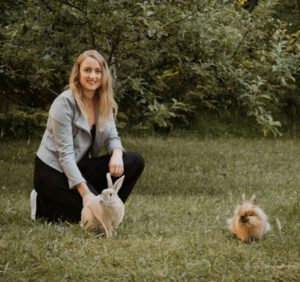What has long been recognized and accounted for in reptiles—the climate and lighting conditions necessary for their health—has often been overlooked by pet owners when it comes to rabbits and rodents. However, small pets also require specific environmental conditions and proper lighting to stay healthy.
Studies have shown that rabbits kept indoors or in hutches, particularly after the winter months, exhibit a measurable deficiency of vitamin D in their blood (Fairham and Harcourt-Brown, 1999).
Contents
- Why Do Indoor and Hutch-Kept Rabbits Suffer from Vitamin D Deficiency?
- Which Sun Rays Are Important?
- Vitamin D Requirements for Rabbits
- How Is the Vitamin D Requirement Met?
- Window Light?
- Natural Light / Outdoor Housing?
- How Long Can Rabbits Store Vitamin D (Over Winter)?
- UVB Lamps?
- Vitamin D in Plants?
- Artificial Vitamin D Supplementation?
- Veterinary Treatment for Severe Deficiency
- Can a Deficiency Be Detected in the Blood?
- Health Consequences of a Deficiency
- Why Is This the Case?
- UVB Lamps for Rabbits in Indoor Housing
- Choosing the Right Lamp for UVB Exposure
- UVB Emitters
- Examples of Suitable Emitters:
- Lamp Holders (Sockets)
- Usage Tips for UVB Lamps
Why Do Indoor and Hutch-Kept Rabbits Suffer from Vitamin D Deficiency?
Window glass blocks the UVB rays necessary for vitamin D synthesis, preventing rabbits from producing this essential nutrient naturally.
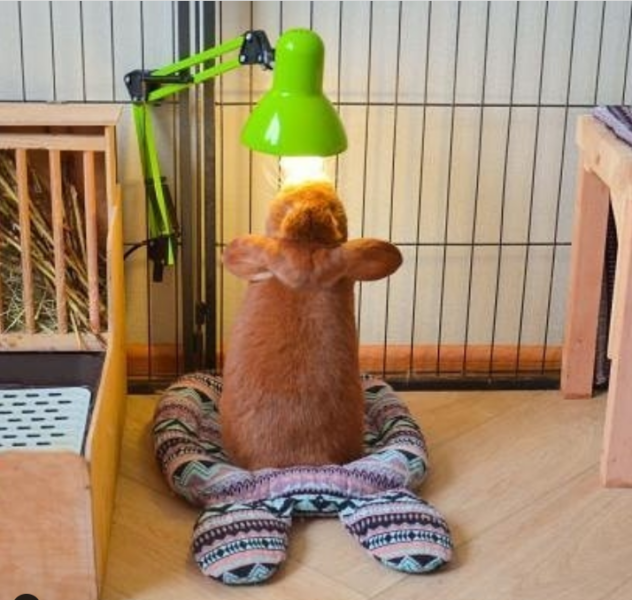
Which Sun Rays Are Important?
There are three types of UV radiation:
- UV-A (320-400 nm)
- UV-B (280-320 nm)
- UV-C (200-280 nm) (harmful to health)
Both UV-A and UV-B rays are essential for health in the right amounts, while UV-C is dangerous.
For rabbits to synthesize vitamin D, they require sufficient UV-B radiation in the range of 295 to 308 nm.
Vitamin D Requirements for Rabbits
The exact vitamin D requirement for rabbits has not been definitively determined. In practice, 300-1200 IU of vitamin D per kilogram of complete feed has been found effective for lactating, growing, or pregnant rabbits. For supplementary feeds, a higher dosage is required. However, it remains uncertain whether this might lead to overdose-related issues, as potential consequences have not yet been thoroughly studied.
When converting the vitamin D content in complete feeds (900 IU/kg for growth/lactation/pregnancy and 800-1200 IU/kg for pet rabbits) to the average dry matter intake, the requirement can be estimated at 31 IU per kg body weight per day, which corresponds to less than 1 μg per kg body weight per day.
This low requirement is likely due to the crepuscular (active at dawn and dusk) and burrow-dwelling nature of rabbits, meaning they naturally receive less direct sunlight compared to diurnal animals.
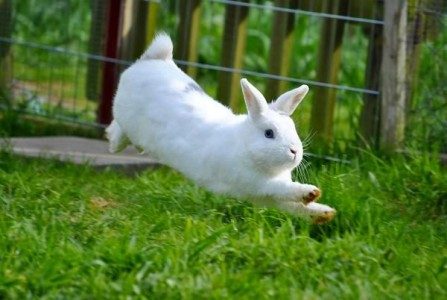
How Is the Vitamin D Requirement Met?
Window Light?
Since window glass blocks UVB rays, which are essential for vitamin D3 synthesis, rabbits need at least 10 minutes of direct sunlight (without window glass) daily to produce enough vitamin D3.
Natural Light / Outdoor Housing?
- In winter, natural daylight contains very little UVB radiation.
- In summer, it is an ideal source of UVB rays.
- To ensure adequate vitamin D production, rabbits should have access to direct sunlight through open windows, garden enclosures, or balconies without glass barriers.
How Long Can Rabbits Store Vitamin D (Over Winter)?
Rabbits can store vitamin D3 for a certain period. For example, rabbits that spend summer outdoors and stay indoors only in winter can rely on their stored vitamin D3 and occasional direct sunlight for about five months (Brommage et al., 1988).
UVB Lamps?
If natural daylight (without window glass) is not available, UVB lamps can be used as an alternative (see details below).
Vitamin D in Plants?
Some plants contain vitamin D, especially sun-dried plants, avocados, and mushrooms. Many wild herbs also contain small amounts, such as:
- Dandelion
- Watercress
- St. John’s Wort
- Nettle
However, sunlight cannot be replaced by food sources, as the vitamin D content in plants is far too low compared to sunlight exposure.
Artificial Vitamin D Supplementation?
- Enriched food or vitamin D drops can provide synthetic vitamin D.
- This can be useful temporarily in cases of severe deficiency due to prolonged indoor housing.
- Long-term supplementation is not recommended, as vitamin D is fat-soluble and excess amounts are stored in the body rather than excreted, which can lead to health risks.
- If supplementation is necessary, a low-dose option should be used, such as JR Farm Grainless Herbs (a dry food available in pet stores).
💡 Alternative: UVB Lamps
UVB radiation is not only essential for vitamin D synthesis but also serves other important functions in the body. Using UVB lamps is safer and more beneficial than synthetic supplementation.
Veterinary Treatment for Severe Deficiency
- If a severe vitamin D deficiency is diagnosed, supplementation can be done using Rodicare Derma (1 pump = 4 IU vitamin D3).
- In acute cases, veterinarians can administer vitamin D injections, such as Veyx VeyFo Vit ADE-aquosum (0.1 ml = 100 IU vitamin D).
UV-A rays are also important, and they can pass through window glass to reach the skin. This means that a bright spot near a window is an ideal location for a rabbit enclosure, as UV-A rays support the immune system, metabolism, and overall vitality of the animals. If rabbits live in an environment with limited natural daylight, a daylight lamp should be installed.
Can a Deficiency Be Detected in the Blood?
Yes, vitamin D levels can be measured in the blood. However, this test is not yet routinely offered.
A study found that a blood level below 17 ng/mL (equivalent to 42.5 nmol/L) of 25-hydroxy-vitamin D (the precursor of biologically active vitamin D in the body) indicates a deficiency.
Nearly one-third of the rabbits tested in the study were found to have a vitamin D deficiency.
| 1,25-(OH)2D3 | Reference range in pmol/l |
| Predominantly indoor housing (partly with enriched feed) | 7,83 +/- 11,2 |
| With access to the outdoors | 34,3 +/- 20,45 |
| Wild rabbits | 58 |
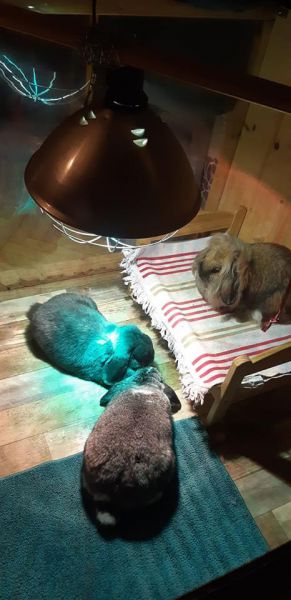
Health Consequences of a Deficiency
UVB rays are essential for vitamin D synthesis, calcium metabolism, and immune function. A deficiency in vitamin D can lead to the following health issues in rabbits:
- Rickets or bone softening (Osteomalacia) – associated with muscle and bone pain
- Dental diseases – due to poor mineralization of continuously growing teeth (high demand for calcium) or bone softening in the tooth sockets, leading to retrograde tooth growth
- Poor healing of bone fractures
- Insulin deficiency (Insulinopenia) (Nyomba et al., 1984)
- Bladder sludge, kidney stones, and kidney grit
- Intestinal inflammation
Why Is This the Case?
Vitamin D plays a crucial role in calcium absorption through the intestine in rabbits, although large amounts of calcium can be absorbed without it. However, if insufficient amounts are consumed, vitamin D becomes important, influencing calcium absorption (Brommage et al., 1988).
In addition to its role in calcium absorption, vitamin D directly affects the mineralization of bones and teeth.
- Vitamin D improves fracture healing in laboratory rabbits (Omeroglu et al., 1997) and promotes mineralization of rabbit chondrocytes in a test tube (Plachot et al., 1982).
- It also contributes to the maintenance of calcium homeostasis by affecting the renal excretion of calcium and phosphorus (Bourdeau et al., 1986). In rabbits, more calcium is excreted through the kidneys compared to other species, especially when there are high levels of calcium in the blood (Whiting & Quamme, 1984).
Through its effects on the excretion of calcium and phosphorus by the kidneys, vitamin D helps maintain calcium balance. In rabbits, parathyroid hormone, calcitonin, and vitamin D regulate blood calcium concentrations, but unlike other animals, rabbits show a reduction in parathyroid hormone concentrations at higher calcium levels in the blood (Warren et al., 1989).
In cases of chronic vitamin D deficiency in adult rabbits, there is poor phosphorus absorption from the diet, leading to bone softening (osteomalacia) (Bourdeau et al., 1986; Brommage et al., 1988).
The altered bone density caused by vitamin D deficiency particularly affects the alveolar bones, which can result in retrograde tooth growth due to the pressure from chewing. This theory is supported by the observation that rabbits with dental diseases show reduced bone density in their skulls.
Dental diseases thus arise as a consequence.
Additionally, urinary excretion of calcium and phosphorus is significantly reduced in cases of vitamin D deficiency, which can lead to the deposition of minerals in the urinary tract, resulting in urolithiasis (kidney stones and bladder stones).
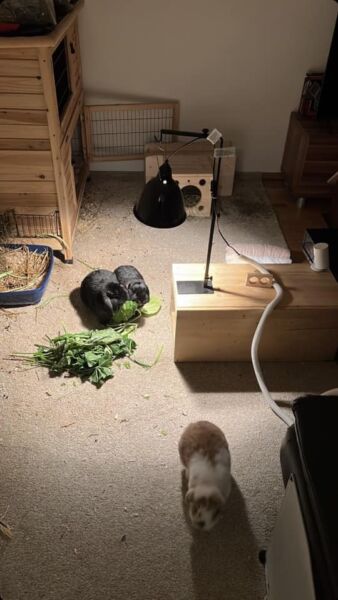
UVB Lamps for Rabbits in Indoor Housing
For those who don’t have access to sufficient direct sunlight, UVB lamps can be a helpful alternative. A study has shown that UVB lamp exposure can double the blood vitamin D levels within 14 days.
In another study, the long-term effects of UVB radiation were tested over six months on rabbits and guinea pigs. The results indicated that UVB exposure had no side effects and significantly increased the vitamin D levels in their blood.
„No obvious negative clinical or pathological side effects were observed between the treatment and control animals. This study found that the exposure of guinea pigs and rabbits to UVB radiation significantly increased their circulating serum levels and that this increase was maintained over a long period. In vertebrates, vitamin D is an essential hormone that regulates many different functions in the body and can offer protection against various health conditions. The use of UVB lamps should be an important consideration for guinea pigs, rabbits, or other diurnal rodents, although unfortunately, it is not yet generally recommended.“
— Megan Watson
Choosing the Right Lamp for UVB Exposure
Not all daylight lamps are suitable for UVB exposure. Full-spectrum daylight lamps are not appropriate, as they primarily emit UVA rays. When purchasing a UVB lamp, pay attention to the UVB values.
- Choose a lamp with a UV-B intensity of up to 270 µw/cm² – this is the equivalent of midday sunlight in Germany. Any higher intensity may be too strong for rabbits, as very few rabbits would naturally sunbathe in midday sunlight.
- If the UVB value is not specified, opt for bulbs designed for desert-dwelling animals with a high UVB output.
There are generally three types of UVB lamps:
- UVB Emitters
- UVB Fluorescent Tubes
- UVB Incandescent Bulbs
UVB Emitters
- These bulbs get very hot (so they should not be left unattended and should be used at a safe distance from the animals).
- UVB Emitters have high UVB output, so they should be used for short periods each day. They are best used when you are at home to monitor their use.
- Ensure that the lamp socket is compatible with the high heat output of the UVB emitter.
Examples of Suitable Emitters:
- Osram Vitalux 300 Watt (Caution: high power consumption!)
- Replux UV Heat D3 Spot 100 Watt (or 160 Watt)
Lamp Holders (Sockets)
- For UVB emitters, you’ll need special ceramic sockets or heat-resistant fittings.
- Examples:
- Piglet lamp holder (metal holder for UVB emitters)
- Clamp lamp (replace the regular bulb with a UVB bulb)
- Clamp lamp with ceramic socket
- Metal stand with lamp holder
By carefully selecting and using the right UVB lamp, you can ensure your rabbit receives adequate UVB exposure for vitamin D synthesis and overall health.
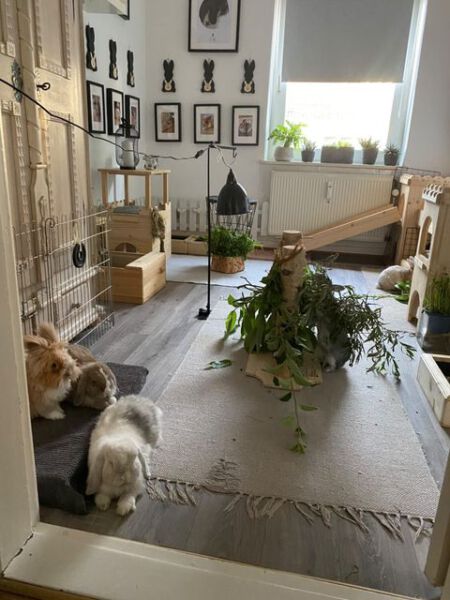
UVB Incandescent Bulbs
UVB incandescent bulbs have a lower power consumption, do not get warm, and can be installed in standard lamp sockets. However, they must be lit for many hours each day and placed close enough to the rabbit to provide sufficient UVB exposure. They can be effectively installed using a simple clamp lamp or reading lamp. To protect the cable, you can easily cover it with a piece of transparent garden hose by slit-open and inserting the cable inside.
Examples of suitable bulbs:
- Terra Exotica
- Extreme UVB Compact Lamp
- Reptile UVB 200 (requires long operating hours, but has low power consumption)
- A suitable clamp lamp (E27 socket)
UVB Fluorescent Tubes
UVB fluorescent tubes, when equipped with an appropriate reflector and ballast, are excellent for providing broad-area UVB irradiation in enclosures, making them suitable even for housing multiple rabbits. Although they tend to generate considerable heat, their UVB output is slightly lower than that of UVB emitters but higher than that of incandescent bulbs.
Example of a suitable fluorescent tube:
- Exo Terra Reptil UVB 100

Usage Tips for UVB Lamps
Replace Regularly:
Be aware that all types of UVB lamps emit significantly more UVB at the beginning of their lifespan than after extended use, so they should be replaced regularly. Most lamps need to be changed on an annual basis!
Installation:
- Distance: Follow the minimum distance specified for each product relative to your rabbits.
- Partial Illumination: It’s best to illuminate only part of the enclosure—especially with stronger lamps—so that the rabbits have the option to avoid the light if they wish.
- Guideline: Use the level of midday sunlight in Germany (UVB intensity up to 270 µw/cm²) as a reference. For example, if a distance of 30 cm from the animal yields 300 µw/cm², then maintain a distance slightly greater than 30 cm.
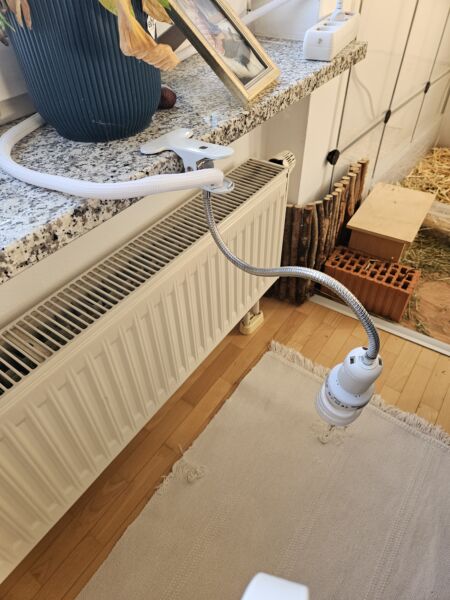
UVB Lamps and the Rabbits:
- Scheduled Use: You can set fixed operating times for the lamp using a timer (e.g., 8–9 AM in the morning and 8–9 PM in the evening) or manually switch it on when you return from work.
- Habituation: Rabbits usually adapt to these schedules and will often lie down under the lamps, enjoying the light.
- Remote Control: If you incorporate a remote-controlled plug, you can turn the lamp on and off remotely depending on whether the rabbits are under the light at that moment.
What If the Rabbit Doesn’t Use the Lamp?
If your rabbit isn’t using the lamp, you can simply install it above the feeding area during meal times to encourage exposure.
Albino Rabbits and UVB Lamps:
Albino rabbits have very sensitive eyes and are prone to sunburn, so UVB lamps should not be used for them.
Sources, among others:
Bouhtiauy, I., Lajeunesse, D., & Brunette, M. G. (1993): Effect of vitamin D depletion on calcium transport by the luminal and basolateral membranes of the proximal and distal nephrons. Endocrinology, 132(1), 115-120.
Bourdeau, J. E., Schwer-Dymerski, D. A., Stern, P. H., & Langman, C. B. (1985): Calcium and phosphorus metabolism in chronically vitamin D-deficient laboratory rabbits. Mineral and electrolyte metabolism, 12(3), 176-185
Brommage, R., Miller, S. C., Langman, C. B., Bouillon, R., Smith, R., & Bourdeau, J. E. (1988): The effects of chronic vitamin D deficiency on the skeleton in the adult rabbit. Bone, 9(3), 131-139.
Curry O B, Basten J F, Francis M J O & Smith R (1974): Calcium uptake by sarcoplasmic reticulum of muscle from vitamin D deficient rabbits. Nature 249, 83-84
Fairham, J., & Harcourt-Brown, F. M. (1999): Preliminary investigation of the vitamin D status of pet rabbits. The Veterinary Record, 145(16), 452-454.
Harcourt-Brown, F. M. (1996): Calcium deficiency, diet and dental disease in pet rabbits. The Veterinary Record, 139(23), 567-571.
Harcourt‐Brown, F. (2006): Metabolic bone disease as a possible cause of dental disease in pet rabbits. Thesis for Fellowship of Royal College of Veterinary Surgeons, UK
Harcourt‐Brown, F. (2007): Radiographic signs of renal disease in rabbits. Veterinary Record 160, 7877‐7894
Harcourt‐Brown, F. (2009): Dental disease in pet rabbits 1. Normal dentition, pathogenesis and aetiology. In Practice 31, 370‐379
Harcourt‐Brown, F. M., & Baker, S. J. (2001): Parathyroid hormone, haematological and biochemical parameters in relation to dental disease and husbandry in rabbits. Journal of Small Animal Practice, 42(3), 130-136.
Jekl, V. (2013): Rabbit dental disease and calcium metabolism–the science behind divided opinions
Kamphues J., Carstensen P., Schroeder D., Meyer H., Schoon H.A., Rosenbruch M., (1986): Effects of increasing calcium and vitamin D supply on calcium metabolism of rabbits. J. Anim. Physiol. a. Anim. Nutr., 56, 191-208.
Kato J (1966): Effects of the administration of vitamin D2, D3, parathyroid hormone and calcium on hypocalcification of rabbit dentine and on changes in blood constituents caused by experimental rickets. Gunma J Med Sci 15, 174-193
Lebas, F. (2000): Vitamins in rabbit nutrition Literature review and recommandations
Mäkitaipale, J., Sankari, S., Sievänen, H., & Laitinen-Vapaavuori, O. (2020): The relationship between serum 25-hydroxyvitamin D and parathyroid hormone concentration in assessing vitamin D deficiency in pet rabbits. BMC Veterinary Research, 16(1), 1-8.
Mitchel, A. et al (2014): Effects of ultraviolet radiation produced from artificial lights on serum 25-hydroxyvitamin D concentration in captive domestic rabbits (Oryctolagus cuniculi). American Journal of Veterinary Research or http://avmajournals.avma.org/doi/abs/10.2460/ajvr.75.4.380?url_ver=Z39.88-2003&rfr_id=ori%3Arid%3Acrossref.org&rfr_dat=cr_pub%3Dpubmed& (Stand: Dez. 2014)
Mosallanejad, B., Moarrabi, A., Avizeh, R., Ghadiri, A. (2010): Prevalence of dental malocclusion and root elongation in pet-rabbits of Ahvaz
Nyomba, B. L., Bouillon, R., & De Moor, P. (1984): Influence of vitamin D status on insulin secretion and glucose tolerance in the rabbit. Endocrinology, 115(1), 191-197.
Ömeroĝlu, H., Ates, Y., Akkuş, O., & Korkusuz, F. (1997): Biomechanical analysis of the effects of single high-dose vitamin D 3 on fracture healing in a healthy rabbit model. Archives of orthopaedic and trauma surgery, 116(5), 271-274.
Plachot, J. J., Du Bois, M. B., Halpern, S., Cournot-Witmer, G., Garabedian, M., & Balsan, S. (1982): In vitro action of 1, 25-dihydroxycholecalciferol and 24, 25-dihydroxycholecalciferol on matrix organization and mineral distribution in rabbit growth plate. Metabolic Bone Disease and Related Research, 4(2), 135-142.
Praag, van, Esther (2014): Vitamin D deficiency in rabbits
Warren, H. B., Lausen, N. C., Segre, G. V., El-Hajj, G. H. A. D. A., & Brown, E. M. (1989): Regulation of calciotropic hormones in vivo in the New Zealand white rabbit. Endocrinology, 125(5), 2683-2690.
Watson,M. (2014): Evaluating the clinical and physiological effects of long term ultraviolet B radiation on guinea pigs (Cavia porcellus) and rabbits (Oryctolagus cuniculus). https://www.ideals.illinois.edu/handle/2142/50499 (Stand: Dez. 2014)
Whiting, S. J., & Quamme, G. A. (1984):. Effects of dietary calcium on renal calcium, magnesium and phosphate excretion by the rabbit. Mineral and electrolyte metabolism, 10(4), 217-221.


